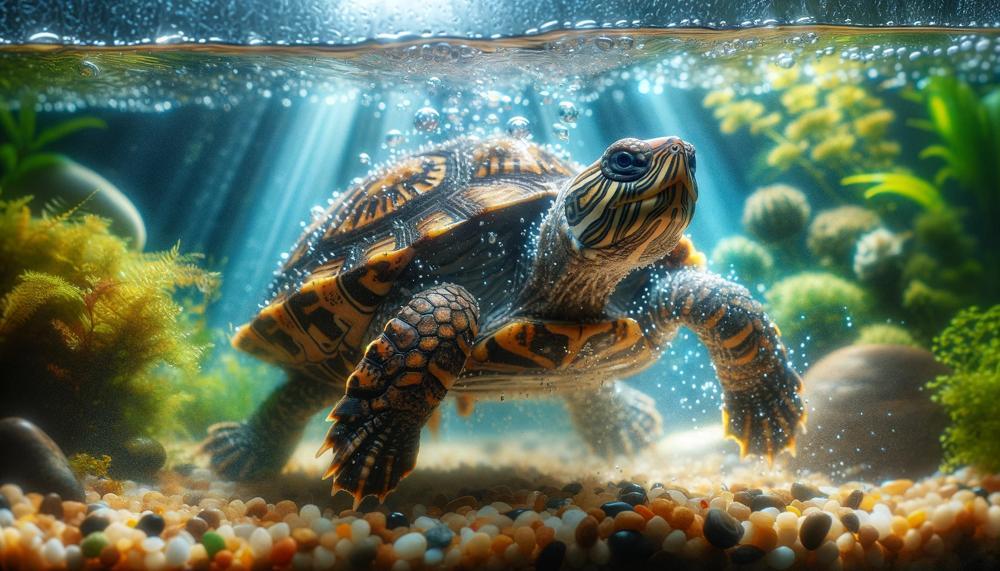Keeping your turtle tank crystal-clear is more than just an aesthetic preference; it’s a cornerstone for maintaining a healthy environment where your turtles can thrive. Navigating the waters of turtle tank maintenance can feel like sailing through murky depths, but fear not.
This guide is your lighthouse, shining a beam of clarity on the essential strategies and tips for preserving pristine conditions in your turtle habitat.
Whether you’re a seasoned turtle keeper or just setting up your first tank, understanding the importance of clean water is crucial for your shelled friends’ health and happiness.
In this article, we’ll dive into the nitty-gritty of turtle tank maintenance, covering:
- The Role of Filtration: How choosing the right filter makes all the difference.
- Regular Water Changes: The what, when, and how of refreshing your tank’s water.
- Maintaining the Right Balance: Tips on managing pH levels and beneficial bacteria.
- Cleanliness Inside and Out: Strategies for cleaning the tank interior and accessories.
- Feeding Practices: How to feed your turtles to minimize water pollution.
Each point is a stepping stone towards achieving a clear and healthy tank environment, ensuring your turtles have the space they need to swim, explore, and grow in water that’s as fresh as a natural spring. Join us as we delve into these aspects, providing you with the knowledge and tools to make murky water a thing of the past.
Get ready to transform your turtle tank into a sparkling oasis that both you and your turtles will love.
Contents
- 1 How To Keep Turtle Tank Water Clean?
- 2 Choosing the Right Filtration System for Your Turtle Tank
- 3 Maintaining Proper Water Temperature for Healthy Turtles
- 4 Regular Water Changes to Keep Turtle Tank Water Clean
- 5 Monitoring pH Levels in Your Turtle Tank
- 6 Avoiding Overfeeding and Adding Live Plants to the Tank
- 7 The Dangers of Direct Sunlight on Turtle Tank Water
- 8 Conclusion
How To Keep Turtle Tank Water Clean?
To maintain pristine waters in a turtle tank, a blend of regular cleaning rituals, judicious feeding, and strategic equipment use is essential. Here’s a simplified guide to ensuring your shelled companions thrive in a clean aquatic environment:
| Practice | Description | Benefit |
| Weekly Water Changes | Replace 25-50% of the tank’s water every week to remove waste and keep the water fresh. | Prevents accumulation of harmful substances and maintains water quality. |
| Quality Filtration | Invest in a robust filter suited to the tank’s size, with mechanical, biological, and chemical filtration capabilities. | Removes debris, waste, and uneaten food, keeping the water clear and healthy. |
| Controlled Feeding | Feed your turtles in moderation, and remove uneaten food after 15-20 minutes to avoid decay and waste buildup. | Minimizes excess waste and pollutants in the water. |
| Regular Tank Scrubbing | Clean the tank’s interior, decorations, and surfaces regularly to prevent algae and slime buildup. | Keeps the tank’s ecosystem balanced and visually appealing. |
| Water Quality Checks | Regularly test the water for ammonia, nitrite, nitrate, and pH levels to ensure they are within safe ranges. | Helps in early detection of imbalances and prevents potential health issues. |
| Optimal Tank Setup | Ensure the tank is spacious, with proper lighting and temperature, to mimic natural conditions. | Reduces stress and promotes healthy, natural behaviors in turtles. |
By adhering to these practices, you’ll foster a habitat not just for survival but for your turtles to flourish.
Choosing the Right Filtration System for Your Turtle Tank
Choosing the right filtration system for your turtle tank isn’t just about keeping the water crystal clear; it’s about crafting a habitat where your shelled mates can thrive.

Here’s a straightforward guide to navigating the murky waters of filtration selection, ensuring your turtles have the pristine environment they deserve.
| Factor | Consideration | Why It Matters |
| Tank Size and Volume | Larger tanks require more powerful filters. | Ensures efficient water cleaning across all tank areas. |
| Turtle Type and Number | More/bigger turtles = greater filtration need. | Addresses the higher waste output efficiently. |
| Filter Type | Canister, HOB, Internal. | Matches the tank size and maintenance ease. |
| Filter Media | Mechanical, Biological, Chemical. | Targets different water cleaning aspects for a comprehensive solution. |
| Maintenance | Frequency of cleaning/replacing media. | Keeps the filter running smoothly, ensuring a healthy tank environment. |
| Water Quality Monitoring | Regular testing and observation. | Prevents health issues by keeping water parameters in check. |
| Signs to Replace Filter | Reduced flow, unusual noises. | Indicates the filter is struggling, potentially compromising water quality. |
| Recommended Filter | External canister filters. | Offers a balance of power and efficiency, ideal for turtle tanks. |
| Water Flow | Consistent without strong currents. | Ensures a comfortable environment for turtles without stressing them. |
Selecting the right filtration system is akin to setting the stage for your turtles’ daily adventures. It’s about creating a sanctuary that’s not just survivable, but utterly thriveable.
Maintaining Proper Water Temperature for Healthy Turtles
Ensuring the water in your turtle tank stays at the proper temperature is pivotal for your turtle’s well-being. Turtles thrive in a stable, warm aquatic environment that mimics their natural habitat. Let’s dive straight into how you can maintain this critical aspect of turtle care with precision and ease.
Steady and Warm: The Turtle Tank Temperature Guide
| Monitoring Mastery | Invest in a reliable thermometer. Aim to keep water temps snug between 75-80°F (24-27°C). |
| Stability is Key | Avoid quick temperature shifts. These can unsettle and harm your shell-backed friend. |
| Heat with Heart | During the chill, a submersible heater becomes your tank’s best ally. It’s a warmth wizard. |
| Location, Location | Keep the tank away from sunbeams and heaters to prevent unpredictable temp tumbles or hikes. |
| Filter Fitness | A clean filter ensures smooth water flow and even temperatures. Check and maintain it regularly. |
| Ambient Awareness | Remember, the room’s climate influences your tank. Keep it consistent for your turtle’s sake. |
Implementing these strategies isn’t just about following steps; it’s about creating a sanctuary where your turtle can flourish. A thermometer isn’t merely a tool; it’s your window into your pet’s comfort zone. A heater does more than warm water; it weaves a web of well-being around your turtle, ensuring its habitat is a haven, not a hazard.
Submersible heaters, when used wisely, act not as mere appliances but as guardians of warmth, warding off the chill that threatens your turtle’s health. The right tank location shields your aquatic buddy from the whims of weather and whim, offering a stable stage upon which the story of its life unfolds.
The humble filter, often overlooked, is the heart of habitat hygiene, pumping purity and peace of mind into your pet’s world. And never underestimate the ripple effect of room temperature on your tank’s tranquil waters.
In essence, every action you take weaves into the larger tapestry of turtle care, ensuring your shelled companion not only survives but thrives. With attention, affection, and adherence to these guidelines, you create not just a tank, but a sanctuary, a slice of the wild tailored to the needs of your turtle.
Regular Water Changes to Keep Turtle Tank Water Clean
A sparkling clean tank is more than just pleasing to the eye; it’s a cornerstone of your turtle’s health and happiness. The frequency of water changes in a turtle tank is a topic that stirs much debate.
However, sticking to a disciplined schedule ensures that your shelled friend thrives in a clean and healthy habitat.
Water Change Frequency
The consensus among experts suggests a twofold approach to water changes:
- Partial Water Changes: Aim to replace about 25% of the tank water weekly. This routine helps in removing toxins while keeping beneficial bacteria intact.
- Full Water Cleans: Conduct a thorough clean, replacing nearly all the water, once a month. This includes scrubbing the tank walls, substrate, and any decorations to remove algae and other build-ups.
Why This Matters
Turtles are messy creatures by nature, producing a significant amount of waste. This waste, along with uneaten food, contributes to the accumulation of toxins like ammonia and nitrites, which can be harmful to your turtle if not managed properly.
Deep Cleaning Insights
When it comes to deep cleaning:
- Avoid Harsh Chemicals: Never use detergents or soaps. These can leave harmful residues that might poison your turtle.
- Filter Maintenance: Clean your tank’s filter monthly. A clogged filter is inefficient at removing waste and can become a breeding ground for harmful bacteria.
Recommended Practices
| Weekly Task | Monthly Task | Important Notes |
| Replace 25% of water | Deep clean tank | Avoid soaps/detergents |
| Check water quality | Clean filter | Use dechlorinated water for changes |
Adhering to these guidelines not only keeps your turtle’s environment clean but also minimizes the risk of health issues associated with poor water quality.
Monitoring pH Levels in Your Turtle Tank
Monitoring the pH levels in your turtle tank is pivotal for ensuring a hospitable environment for your shelled companions. The sweet spot for pH in a turtle’s habitat hovers between 6.5 and 7.5, though this can wiggle a bit depending on your turtle’s species.
Keeping an eagle eye on this range is essential for your turtle’s health, as stray pH levels can usher in stress, a dip in immune function, and a host of other unwelcome health woes.
How Often to Test the Waters
It’s wise to test the pH levels weekly. This regular check-up can help you catch any drastic pH shifts before they morph into a bigger issue for your turtle’s well-being.
Accurate Monitoring Methods
| Method | Description | Pros and Cons |
| pH Testing Kits | Liquid reagents or test strips designed for aquatic habitats. | Simple and cost-effective but less precise than digital meters. |
| pH Meters | Electronic devices that offer digital pH readings. | More accurate but require calibration and are pricier. |
| Natural Indicators | Using elements like peat moss or limestone to gauge changes. | Indirect method; beneficial for adjustments but not precise measurement. |
To sustain balanced pH levels, consistency is your ally. Regularly changing the water, maintaining your filter, and avoiding overcrowding can stave off pH imbalances. Should your tank’s pH need adjusting, natural options like driftwood or crushed coral offer a gentler approach than chemical adjusters, meshing well with your turtle’s environment without causing sharp, unhealthy changes.
Remember, the shell game of managing your turtle’s tank isn’t just about keeping the water clean—it’s about maintaining a stable, healthy environment that mirrors their natural habitat as closely as possible.
Avoiding Overfeeding and Adding Live Plants to the Tank
Adding live plants to a turtle tank plays a pivotal role in maintaining water clarity and overall ecosystem health.
These natural purifiers excel in absorbing excess nutrients such as ammonia and nitrates, by-products of turtle waste that can quickly accumulate, leading to murky conditions and potentially harmful environments for your shelled companions.
Moreover, live plants compete with algae for nutrients, effectively limiting the latter’s growth and ensuring your tank remains cleaner and aesthetically pleasing. Here’s a breakdown of the benefits:
| Benefit | Explanation | Impact |
| Absorption of Excess Nutrients | Plants take up ammonia and nitrates from turtle waste. | Reduces potential for water toxicity, promoting a healthier environment. |
| Algae Growth Reduction | Compete with algae for nutrients, limiting its proliferation. | Keeps tank walls and water cleaner, enhancing visual appeal. |
| Oxygenation of Water | Photosynthesis process adds oxygen to the tank water. | Improves water quality for turtles, supporting their respiratory health. |
Incorporating live plants not only bolsters the tank’s filtration system by natural means but also enriches the habitat, mimicking the turtle’s natural environment.
The Dangers of Direct Sunlight on Turtle Tank Water
Direct sunlight, a double-edged sword for turtle tanks, impacts water cleanliness both positively and negatively. While sunlight fuels the growth of beneficial bacteria, essential in waste breakdown and toxin elimination, its overabundance fosters algae proliferation, clouds water, and disrupts ecosystems.
Excessive algae not only mars the tank’s beauty but also depletes oxygen, endangering turtle health. Furthermore, sunlight-induced thermal shifts stress turtles, potentially triggering disease susceptibility or, in severe shifts, mortality.
To sidestep these risks, employing protective measures against undue sunlight exposure is paramount. Strategies encompass shading the tank to temper sunlight’s intensity, particularly during its zenith, and regulating light penetration using drapes or relocating the tank from direct sun paths. Regular tank upkeep further curbs algae and preserves water quality.
| Precaution | Description | Benefits |
| Shade Provision | Employ covers or position tank in shaded locales. | Mitigates overheating and controls algae growth. |
| Light Regulation | Use curtains or reposition tank away from direct sunlight. | Prevents temperature spikes and excessive algae. |
| Regular Maintenance | Clean tank and water regularly. | Keeps water clear and reduces algae. |
Conclusion
Achieving crystal-clear waters in a turtle tank requires a careful balance of strategy, hard work, and an intimate knowledge of the fragile environment. This thorough guide has made it clear how to keep your turtles in a clean aquatic environment by stressing the value of filtration, frequent water changes, balanced feeding schedules, and the beneficial function that living plants play in a symbiotic relationship.
Turtle keepers have the information to guide their tanks away from the murky depths of neglect and toward the tranquil beaches of health and clarity, much like navigators forging a path across unknown seas.
By following these guidelines, the turtles in the tank are able to flourish and live in ideal condition, transforming from a barren cage.
We build a refuge that mimics the natural beauty and complexity of their original environments while simultaneously warding off the threat of algae and pollution via the careful regulation of feeding, selection of the appropriate filtration system, frequent water quality checks, and the addition of live plants.
The way these components work together guarantees that the tank is more than simply a work of art; it also serves as a reminder of the keeper’s meticulous and compassionate care.
Let this guidance serve as your lighthouse, directing your efforts to keep the water so clear that it rivals the natural springs’ purity.






